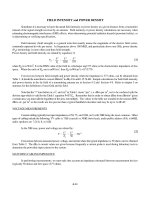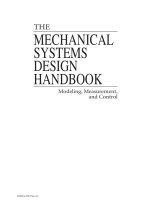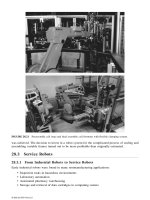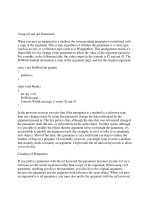Tài liệu UNIVERSITY ENTREPRENEURSHIP AND TECHNOLOGY TRANSFER: PROCESS, DESIGN, AND INTELLECTUAL PROPERTY doc
Bạn đang xem bản rút gọn của tài liệu. Xem và tải ngay bản đầy đủ của tài liệu tại đây (2.32 MB, 335 trang )
UNIVERSITY ENTREPRENEURSHIP
AND TECHNOLOGY TRANSFER:
PROCESS, DESIGN, AND
INTELLECTUAL PROPERTY
i
ADVANCES IN THE STUDY OF
ENTREPRENEURSHIP,
INNOVATION AND ECONOMIC
GROWTH
Series Editor: Gary D. Libecap
Recent Volumes:
Volume 10:
Legal, Regulatory and Policy Changes that Affect
Entrepreneurial Midsize Firms, 1998
Volume 11: The Sources of Entrepreneurial Activity, 1999
Volume 12: Entrepreneurship and Economic Growth in the
American Economy, 2000
Volume 13: Entrepreneurial Inputs and Outcomes: New
Studies of Entrepreneurship in the United States,
2001
Volume 14: Issues In Entrepreneurship: Contracts, Corporate
Characteristics and Country Differences, 2002
Volume 15:
Intellectual Property and Entrepreneurship, 2004
ii
ADVANCES IN THE STUDY OF ENTREPRENEURSHIP,
INNOVATION AND ECONOMIC GROWTH VOLUME 16
UNIVERSITY
ENTREPRENEURSHIP
AND TECHNOLOGY
TRANSFER: PROCESS,
DESIGN, AND
INTELLECTUAL
PROPERTY
EDITED BY
GARY D. LIBECAP
The University of Arizona, USA
2005
Amsterdam – Boston – Heidelberg – London – New York – Oxford
Paris – San Diego – San Francisco – Singapore – Sydney – Tokyo
iii
ELSEVIER B.V.
Radarweg 29
P.O. Box 211
1000 AE Amsterdam
The Netherlands
ELSEVIER Inc.
525 B Street, Suite 1900
San Diego
CA 92101-4495
USA
ELSEVIER Ltd
The Boulevard, Langford
Lane, Kidlington
Oxford OX5 1GB
UK
ELSEVIER Ltd
84 Theobalds Road
London
WC1X 8RR
UK
r 2005 Elsevier Ltd. All rights reserved.
This work is protected under copyright by Elsevier Ltd, and the following terms and conditions apply to its use:
Photocopying
Single photocopies of single chapters may be made for personal use as allowed by national copyright laws. Permission
of the Publisher and payment of a fee is required for all other photocopying, including multiple or systematic copying,
copying for advertising or promotional purposes, resale, and all forms of document delivery. Special rates are
available for educational institutions that wish to make photocopies for non-profit educational classroom use.
Permissions may be sought directly from Elsevier’s Rights Department in Oxford, UK: phone (+44) 1865 843830, fax
(+44) 1865 853333, e-mail: Requests may also be completed on-line via the Elsevier
homepage ( />In the USA, users may clear permissions and make payments through the Copyright Clearance Center, Inc., 222
Rosewood Drive, Danvers, MA 01923, USA; phone: (+1) (978) 7508400, fax: (+1) (978) 7504744, and in the UK
through the Copyright Licensing Agency Rapid Clearance Service (CLARCS), 90 Tottenham Court Road, London
W1P 0LP, UK; phone: (+44) 20 7631 5555; fax: (+44) 20 7631 5500. Other countries may have a local reprographic
rights agency for payments.
Derivative Works
Tables of contents may be reproduced for internal circulation, but permission of the Publisher is required for external
resale or distribution of such material. Permission of the Publisher is required for all other derivative works, including
compilations and translations.
Electronic Storage or Usage
Permission of the Publisher is required to store or use electronically any material contained in this work, including any
chapter or part of a chapter.
Except as outlined above, no part of this work may be reproduced, stored in a retrieval system or transmitted in any
form or by any means, electronic, mechanical, photocopying, recording or otherwise, without prior written permission
of the Publisher.
Address permissions requests to: Elsevier’s Rights Department, at the fax and e-mail addresses noted above.
Notice
No responsibility is assumed by the Publisher for any injury and/or damage to persons or property as a matter of
products liability, negligence or otherwise, or from any use or operation of any methods, products, instructions or
ideas contained in the material herein. Because of rapid advances in the medical sciences, in particular, independent
verification of diagnoses and drug dosages should be made.
First edition 2005
British Library Cataloguing in Publication Data
A catalogue record is available from the British Library.
ISBN: 0-7623-1230-0
ISSN: 1048-4736 (Series)
∞ The paper used in this publication meets the requirements of ANSI/NISO Z39.48-1992 (Permanence of Paper).
Printed in The Netherlands.
Working together to grow
libraries in developing countries
www.elsevier.com | www.bookaid.org | www.sabre.org
iv
CONTENTS
LIST OF CONTRIBUTORS
vii
INTRODUCTION
Gary D. Libecap
ix
ANALYZING THE EFFECTIVENESS OF UNIVERSITY
TECHNOLOGY TRANSFER: IMPLICATIONS FOR
ENTREPRENEURSHIP EDUCATION
Donald S. Siegel and Phillip H. Phan
1
THE BAYH-DOLE ACT AND HIGH-TECHNOLOGY
ENTREPRENEURSHIP IN U.S. UNIVERSITIES:
CHICKEN, EGG, OR SOMETHING ELSE?
David C. Mowery
39
THE KNOWLEDGE SPILLOVER THEORY OF
ENTREPRENEURSHIP AND TECHNOLOGICAL
DIFFUSION
David B. Audretsch, Max Keilbach and Erik Lehmann
69
CURIOSITY-DRIVEN RESEARCH AND UNIVERSITY
TECHNOLOGY TRANSFER
Katherine J. Strandburg
93
THE IRRATIONALITY OF SPECULATIVE GENE
PATENTS
David E. Adelman
v
123
vi
CONTENTS
COMMERCIALIZING UNIVERSITY RESEARCH
SYSTEMS IN ECONOMIC PERSPECTIVE: A VIEW
FROM THE DEMAND SIDE
Brett M. Frischmann
155
PROS AND CONS OF FACULTY PARTICIPATION IN
LICENSING
Jerry G. Thursby and Marie C. Thursby
187
INTRODUCING TECHNOLOGY
ENTREPRENEURSHIP TO GRADUATE EDUCATION:
AN INTEGRATIVE APPROACH
Marie C. Thursby
211
AN INTEGRATED MODEL OF UNIVERSITY
TECHNOLOGY COMMERCIALIZATION AND
ENTREPRENEURSHIP EDUCATION
Arthur A. Boni and S. Thomas Emerson
241
ORGANIZATIONAL MODULARITY AND
INTRA-UNIVERSITY RELATIONSHIPS BETWEEN
ENTREPRENEURSHIP EDUCATION AND
TECHNOLOGY TRANSFER
Andrew Nelson and Thomas Byers
275
LIST OF CONTRIBUTORS
David E. Adelman
The University of Arizona, Tucson, AZ,
USA
David B. Audretsch
Ameritech Chair of Economic
Development, Indiana University, Institute
for Development Strategies, Bloomington,
IN, USA
Arthur A. Boni
Tepper School of Business, Carnegie
Mellon University, Pittsburgh, PA, USA
Thomas Byers
Stanford University, Stanford, CA, USA
S. Thomas Emerson
Tepper School of Business, Carnegie
Mellon University, Pittsburgh, PA, USA
Brett M. Frischmann
Loyola University Chicago School of Law,
Chicago, IL, USA
Max Keilbach
Max Planck Institute of Economics,
Entrepreneurship, Growth and Public
Policy Research Group, Jena, Germany
Erik Lehmann
Max Planck Institute of Economics,
Entrepreneurship, Growth and Public
Policy Research Group, Jena, Germany
Gary D. Libecap
The University of Arizona, Tucson, AZ,
USA
David C. Mowery
University of California, Berkeley,
Berkeley, CA, USA
Andrew Nelson
Stanford University, Stanford, CA, USA
Phillip H. Phan
Rensselaer Polytechnic Institute, Troy, NY,
USA
Donald S. Siegel
Rensselaer Polytechnic Institute, Troy, NY,
USA
vii
viii
LIST OF CONTRIBUTORS
Katherine J.
Strandburg
DePaul University, College of Law,
Chicago, IL, USA
Jerry G. Thursby
Department of Economics, Emory College,
Emory University, Atlanta, GA, USA
Marie C. Thursby
College of Management, Georgia Institute
of Technology, Atlanta, GA, USA
INTRODUCTION
American universities, indeed, universities throughout the world, are facing
increased demand to share the knowledge developed within their campuses.
Historically, students pass knowledge to the greater society. But since at
least the 1960s, the university’s research role has dramatically increased,
with more and more resources devoted to basic and applied research in the
physical and biological sciences, engineering, humanities, social sciences,
and management fields. Not all of this research can be transmitted through
the graduation of students. Research on basic scientific and life processes
and engineering also eventually results in applications in new products and
processes. Given the large investment in university research, society naturally seeks greater returns through patents, licensing, and new business
starts. Local and state governments, especially, look to universities for job
creation and economic growth through greater knowledge transfer.
In addition to these external demands, administrators and faculty within
universities grow more interested in the potential from knowledge transfer.
They believe students have better chances for employment with experience
in commercialization; they believe that revenues from royalties and other
licensing revenue can augment declining government support of their academic programs; they believe that the academic reputation of their institutions can be enhanced with greater success in knowledge transfer; and
finally, they believe that all levels of government will be more supportive of
the institution if it reveals a clear interest and success in knowledge transfer.
But internal demand does not come only from administrators and faculty.
Students want greater emphasis on the practical application of their university-based knowledge. They want greater training in commercialization,
knowledge that is applicable to real-world problems and hence will be demanded by employers. Finally, they have intellectual demands to see how
university ideas might be modified to meet economic and social needs.
In the face of growing external and internal demands for knowledge
transfer, universities have responded by investing in augmented technology
transfer or licensing offices, adding courses and programs in commercialization, and perhaps most importantly, broadening administrative and academic support for knowledge transfer. The emphasis is no longer solely on
ix
x
INTRODUCTION
the ivory tower. The bioscience and engineering fields, in particular, express
interest in knowledge transfer, and more specifically, technology transfer,
because of the perceived opportunities for patenting and licensing revenues.
Entrepreneurship programs and curricula across colleges and universities
worldwide predates the new interest in knowledge transfer. Entrepreneurship classes that emphasize the process of business plan development and
new launch of business ideas have become some of the most popular in the
academy. Regional, national, and international business plan competitions
allow student teams to practice their presentations, to defend them against
the critical review of judges, and to obtain exposure among angel investors
and venture capitalists. Entrepreneurship programs have grown beyond
business school, which was their traditional home, to engineering, life sciences, agriculture, medical, and humanities programs. Indeed, as entrepreneurship enrollments have grown, there has been a natural interest in
knowledge transfer. New university ideas with potential commercial application are especially attractive to student teams as the basis for their business plans and possible launches. There is greater interaction between
entrepreneurship faculty, students, and those in science and engineering.
University licensing and technology transfer offices are becoming more involved in entrepreneurship activities.
Given all of this progress, it seemed appropriate to gather academics
involved in entrepreneurship education, officers of technology transfer programs, and those who study the process and problems of university-based
knowledge transfer, to discuss what synergies exist and how entrepreneurship and technology transfer might be promoted more effectively. Using a
grant from the Ewing Marion Kauffman Foundation of Kansas City, the
Karl Eller Center at the University of Arizona commissioned 10 papers to
examine the topics of technology transfer, intellectual property, and entrepreneurship program development. The papers were presented at the White
Stallion Ranch, northwest of Tucson, January 20–23, 2005. Participants are
listed at the end of the Introduction, along with the conference program.
The first paper, Chapter 1 of this volume, by Donald S. Siegel and Phillip
H. Phan, Rensselaer Polytechnic Institute, ‘‘Analyzing the Effectiveness of
University Technology Transfer: Implications for Entrepreneurship Education,’’ begins by highlighting some of the major technologies developed from
university laboratories that resulted in the creation of new industries. These
include the 1940s development of the electronic calculator at the University
of Pennsylvania that led to the computer industry, the 1960s launch of fiber
optics at MIT that stimulated telecommunications, the 1970s investigations
in DNA at Stanford and UC Berkeley that provided the basis for the
Introduction
xi
biotechnology industry, the 1980s supercomputing at the University of Illinois that advanced the Internet, and the sequencing of DNA/the Human
Genome at Cal Tech and Johns Hopkins that advanced pharmacogenomics.
These are examples of major hits for technology transfer, but Siegel and
Phan are concerned with the process underlying more routine technology
transfer. They identify the principal agents and institutions for technology
transfer as university scientists, industry scientists who interact with them,
industry–university research centers, university technology transfer offices,
science parks, incubators, firms that interact with universities, and venture
capital firms. They identify indicators of technology transfer output/
performance as invention disclosures, patents, licensing agreements, licensing revenue, research productivity of both industry and university scientists,
startup formation, the survival of startups, and employment growth. Summarized, these metrics illustrate patterns in technology transfer. Siegel and
Phan provide some key stylized facts: patents are not that important for
certain technologies/industries, many scientists do not disclose inventions,
faculty involvement is critical, universities rely on outside lawyers to negotiate with firms, technology transfer office staff add significant value to the
transfer process, no strong evidence supports returns to scale, private universities are somewhat more productive, and incentives in the royalty distribution formula and organizational structure matter in encouraging
faculty in technology transfer. They also present some impediments to
technology transfer, such as information and cultural barriers between universities and firms, especially small firms; insufficient rewards for faculty in
technology transfer; high staff turnover in technology transfer offices; and,
of import to the conference, the education component, for both faculty and
students, in the process of entrepreneurship and business plan development.
Siegel and Phan conclude their chapter with suggestions for promoting
university technology transfer to include, among other things, the development of interdisciplinary entrepreneurship programs that attend to technologies.
Chapter 2, by David Mowery, University of California, Berkeley, ‘‘The
Bayh–Dole Act and High-Technology Entrepreneurship in U.S. Universities: Chicken, Egg, or Something Else?’’ provides a rich historical background on U.S. universities and innovation. Mowery notes that the
university share of basic research in the United States has grown from
33% in 1953 to 60% in 1999. Universities often are associated with the
growth of regional high-tech clusters populated by entrepreneurial firms and
driven by new innovations. American universities influence industrial
innovation through the training of scientists and engineers; publishing
xii
INTRODUCTION
research; consulting with the private sector; interacting informally and
in conferences with industry researchers; obtaining patents and licenses for
university inventions; and establishing new firms led by faculty, graduates,
and other researchers. Since the 1970s patents from university research has
grown, particularly in biomedical fields. Mowery provides long-term data
on the share of university patents among all domestic assigned patents, and
the record reveals an upswing after 1975, with more or less continuous
growth since that time. Also, since 1978, drug/medical patents have outpaced those in chemicals, electrical/electronic, and mechanical. With this
information, Mowery asks if the Bayh-Dole Act of 1980, which gave universities greater authority over licensing terms from federally funded research, was a major source of this observed growth? He conjectures that the
Bayh–Dole Act was more likely the effect, rather than the cause, of increased patenting. Universities such as Purdue, Stanford, MIT, Harvard,
and Columbia lobbied for greater flexibility and consistency in federal policy just as their research and patenting activities were rising. Mowery turns
to the question of how university IPR policy has affected entrepreneurial
firms. He notes that there has been little empirical research in this area, but
summarizes some available data. In 2002, 14–16% of university licensees
were faculty founded startups, and 50–54% of licensees were small, less than
500 employees – these firms were not established to commercialize the specific invention. Patents may play a relatively secondary role in commercialization in non-biomedical fields. To illustrate the relationship between
university patenting and licensing policies and entrepreneurial firms, Mowery provides five case studies, some of which were founded as vehicles for
technology development and acquisition by other firms rather than technology commercialization. There was substantial variation in the level and
nature of inventor involvement in commercialization. In three of the cases,
the firms began work on similar technologies without licenses. These examples show the two-way flow of knowledge between the university and
industry, and the importance of personnel movement between the two as
part of knowledge transfer. The cases reveal little evidence that patenting/
licensing activities were associated with delays in publication of academic
research advances. Mowery also examines university IPR polices. He points
out that universities have unrealistic expectations regarding the level of licensing revenues. Between 1999 and 2003, the entire University of California
system had net institutional revenues of only $15 million a year out
of an annual budget of nearly $3 billion. He addresses issues of how the
management of IPR policies can facilitate licensing and entrepreneurial
growth.
Introduction
xiii
Chapter 3, ‘‘The Knowledge Spillover Theory of Entrepreneurship and
Technological Diffusion,’’ by David Audretsch, Max Keilbach, and Erik
Lehmann of the Max Planck Institute for Research on Entrepreneurship,
Growth, and Public Policy, and Indiana University, provides more detailed
empirical evidence on knowledge spillover using German data. Audretsch,
Keilbach, and Lehmann begin by asking, what is entrepreneurship? The
definitions they provide emphasize creating new products, processes, services, and organizations through the process of opportunity discovery. With
this as background, the authors explore how knowledge is spilled over from
research centers to the broader society to provide the basis for endogenous
growth. They outline an endogenous growth model with knowledge externalities. They hypothesize that entrepreneurship will be greater in the presence of higher investments in new knowledge, and that entrepreneurship will
be spatially located within close proximity to knowledge sources. Audretsch,
Keilbach, and Lehmann estimate the model to test the hypotheses using
German data across local political jurisdictions. They examine the determinants of startups by population and economic growth across the regions.
They find that entrepreneurship as reflected in startups is positively influenced by investments in knowledge, all else being equal, and that entrepreneurship in turn is an important factor in economic growth. The chapter
closes with a discussion of policy implications that may arise if supporting a
spillover of knowledge.
Chapter 4 is the first of three on intellectual property issues associated with
university-based research and commercialization. Katherine J. Strandburg,
DePaul College of Law, writes ‘‘Curiosity-Driven Research and University
Technology Transfer.’’
In this chapter, Strandburg asks two questions – will university patenting
promote commercialization of basic research spin-offs, and does university
patenting threaten traditional scientific norms and basic research? She is
concerned that greater emphasis on commercialization and increased licensing revenues might distort the traditional university focus on curiositydriven research as compared to commercially driven research. Strandburg
argues that basic research is socially valuable and worth protecting and
promoting in developing university technology transfer policies. She notes
that markets will fail to provide the socially optimal demand structure and
that universities, using government funding, are important sources of basic
research. She describes a model of basic academic research, whereby curiosity determines the research selected by scientists, and the peer review
process disciplines for quality. She argues that basic scientists are selfselected by a taste for research, and are thus less likely to be interested in
xiv
INTRODUCTION
short-term commercial goals. Among this group of scientists exist norms
that include communalism, universalism, disinterestedness, skepticism, invention, and independence. After elaborating on each of these norms,
Strandburg asks if increased university emphasis on patenting/tech transfer
will pose a threat. Among her concerns are whether industry funding and
royalties will influence the kinds of research undertaken. She describes some
predictions of her academic research model, including a lack of patenting.
She also outlines some university practices that can be adopted to protect
basic research, including experimental use exemptions in potential patent
infringements.
Chapter 5, ‘‘The Irrationality of Speculative Gene Patents,’’ by David E.
Adelman, James E. Rogers College of Law at the University of Arizona,
continues examination of university IP policies. Adelman notes that biotech
is the center of fears about proliferating patenting by universities and the
private sector. The concern is that aggressive patenting is undermining the
scientific norms, as outlined by Strandburg, and creating a patent ‘‘anticommons.’’ He describes a pronounced surge in the patent of research tools
that were previously more freely available in the public domain, and a
significant rise in defensive patenting, particularly in the genomic sciences.
Adelman argues that speculative biotech patenting, particularly of genetic
probes, putative drug targets, and uncharacterized genetic sequences, is irrational. To develop his argument, he outlines the features of biomedical
science and R&D: there is a complexity of disease processes with numerous
genes involved and a combination of genetic and environmental causes;
there are large uncertainties with weak causal associations between specific
genes, and most diseases and random processes often play a significant role.
With a proliferation of drug targets and genetic data, the challenge is to use
research tools to discover viable products at a time when the drug pipeline
has actually declined for almost a decade. R&D in biotech is shaped by high
costs and uncertainties of discovery versus the low cost and ease of copying.
Biological complexity mitigates the potential for patents to create broad
monopolistic power. Genomic methods have generated a large number of
research tools. As a result, Adelman concludes that there are so many biotech, problem-specific research tools and such high levels of uncertainties of
payoff that patenting makes little sense. The current state of biotech research and development represents the worst conditions for strategic patenting – the number of potential patents is large and the value highly
uncertain. The complexity of human biology creates a further disincentive
for speculative patenting. The redundancy and intricacy of biological processes will enable scientists to circumvent existing problem-specific patents.
Introduction
xv
Enforcement of problem-specific research tools will be prohibitively costly.
In the absence of an infringing product or sale, infringing uses will be very
difficult to identify and the low value of speculative patents will eliminate
the incentive to invest in patent enforcement. Accordingly, Adelman argues
for a tempered university patent policy in biotech.
Chapter 6, ‘‘Commercializing University Research Systems in Economic
Perspective: A View from the Demand Side,’’ by Brett M. Frischmann,
Loyola University Law School, is the last of the three chapters on university
IP trends and technology transfer. Frischmann argues that the issues surrounding commercialization of university research are quite similar to those
surrounding the commercialization of other mixed infrastructure, such as
the Internet. As with Strandburg, Frischmann is concerned about the impact of technology transfer and emphasis on greater royalties on the traditional basic science environment. Universities have to decide how to
allocate infrastructure investment that may be directed toward application
and not basic research. He notes that universities may execute a variety of
different strategies for promoting entrepreneurship, each coinciding with
different degrees of participation in the commercialization process. Universities can be entrepreneurs, support entrepreneurs, and/or educate entrepreneurs. The basic point, according to Frischmann, is that universities need
not be commercial entrepreneurs in order to teach entrepreneurship or
provide students with entrepreneurial opportunities and experience. Indeed,
an active, entrepreneurial university may offer hands-on, practical training
in entrepreneurship for students in the fields of business and science and
technology. Successful commercialization of university research requires
close collaboration among participants in the university science and technology research system and with faculty, students, and administrators. An
interdisciplinary entrepreneurship program provides an excellent environment for commercializing research and educating entrepreneurs. Universities may also opt to be less entrepreneurial while still being involved in the
commercialization process. They may leave the post-patent efforts to licensees or spin-off companies, external investors and entrepreneurs. The need
to coordinate the efforts of scientists, technologists, innovators, investors
and entrepreneurs still provides ample opportunities for entrepreneurship
training. Finally, entrepreneurship need not involve commercial enterprise.
Universities that decide not to make commercialization a priority and instead aim to sustain their science and technology research systems as mixed
infrastructure may still advance entrepreneurship education through open
source, community-based enterprise projects and internships with local
businesses.
xvi
INTRODUCTION
Chapter 7 is the first of four chapters on the links between tech transfer
and university entrepreneurship. ‘‘Pros and Cons of Faculty Participation in
Licensing,’’ is by Jerry G. Thursby, Emory University, and Marie
C. Thursby, Georgia Institute of Technology. The Thursbys begin by stating the importance of university research for industrial innovation. Although
university licensing has increased dramatically, there remains a debate over
faculty involvement as allowed by the Bayh-Dole Act. Proponents of licensing argue that its incentives underwrite the development needed for many
technologies that are being commercialized, while critics argue that publication alone is sufficient for transfer and that licensing diverts faculty from
more basic research. The Thursbys try to bring some needed empirical evidence to the debate. According to their industry survey, disclosures tend to
be concentrated in science, engineering and medicine. Only 40% of disclosures lead to licenses, and less than half of these ever generate income because so many are very early in development. Indeed, the top 5 income
generating licenses bring in 76% of total university licensing incomes. Because of the embryonic nature of university inventions their licenses had a
higher failure rate than non-university technologies. About half of the failures were due to the technology. Fifty-two percent of university inventions
were for new product development and only 9% for process improvement.
The survey found little use of patenting to block entry by rivals, again
probably because of the early stage of university technologies. Using a large
survey data set of 3,342 faculty at 6 major universities over up to 17 years,
the authors find that faculty involvement may be quite limited. Over 64% of
faculty never disclosed discoveries and about 15% disclosed only once. Involvement in licensing appears to have had little impact on the nature of
research with the ratio of basic research publications to all publications
roughly constant over time. To raise faculty awareness there must be improved understanding of applications of their research through commercialization. There also must be greater interaction between faculty and those
involved in commercialization, including technology transfer office personnel, angel investors, and officers of firms. The authors describe the advantages of faculty involvement in licensing, which include potentially greater
disclosures and royalty income, and they outline the disadvantages which
include possible compromises of traditional research agendas. The authors
provide evidence to shed light on these controversial issues. They also examine the factors that encourage or discourage faculty involvement. In conclusion they find little diversion of faculty research agendas. The increase in
licensing lies less with changes in faculty research and more with changes in
the interests of the university central administrations.
Introduction
xvii
Chapter 8, ‘‘Introducing Technology Entrepreneurship to Graduate
Education: An Integrative Approach,’’ by Marie Thursby, Georgia Tech,
describes the very successful program underway at Georgia Tech and Emory. She argues that successful technology commercialization requires the
integration of scientific and engineering expertise with knowledge of management, law, economics, and public policy. Accordingly, the entrepreneurship program centers around student teams that investigate the
commercialization of their business plan research. The targeted students
include PhDs in science and engineering, management and economics, and
MBA and law students. Five factors are included in PhD training – managing R&D for business growth, balancing long-term and short-term R&D,
integrating R&D and business strategy, making innovation happen, and
assessing productivity. For MBA and law students, the emphasis is improved understanding of the technologies. These program objectives are
addressed in the Technological Innovation: Generating Economic Results
(TI:GER) program. The interdisciplinary program outlined in the chapter
includes classes, research, theses, clinics and internships. Professor Thursby
provides outlines of the courses offered, their sequences, and integration
across the student groups. Research objectives also are described.
Chapter 9, ‘‘An Integrated Model of University Technology
Commercialization and Entrepreneurship Education,’’ by Arthur A. Boni
and S. Thomas Emerson, Carnegie Mellon University, outlines a
similar program linking entrepreneurship and technology transfer. The
authors describe university sources of technology, processors of technology,
and the institutional structure and community through which technology
transfer occurs. They then describe the external community involved,
including angel investors, VCs, legal and accounting firms, incubators, trade
organizations, and state and local governments. With this background,
Boni and Emerson describe the importance of aligning the constituencies to
integrate university resources and to interface with external groups to
better transfer knowledge. Their entrepreneurship program is at the center
of this effort. It involves a business school and tech transfer office alliance
to identify faculty and technologies, to address IP problems, and to
locate appropriate commercial partners. The business school educates
and supports entrepreneurs at the MBA level, undergraduate and
non-MBA levels. There is interlinkage with technologists on campus in
business plan development. For national exposure, the university
supports various business plans competitions. Boni and Emerson conclude
with case examples of recent successful launches based on university
technology.
xviii
INTRODUCTION
Chapter 10, ‘‘Organizational Modularity and Intra-University Relationships between Entrepreneurship Education and Technology Transfer,’’ by
Andrew Nelson and Thomas Byers, Stanford University, describes
Stanford’s technology licensing and entrepreneurship education interface
through the engineering school. Nelson and Byers summarize the growth in
patent filings, licenses, and royalty income at Stanford. They also outline the
growth in entrepreneurship education and how these two are linked. Given
the decentralized nature of Stanford, networks are critical, and the authors
describe the networks that have developed to promote technology transfer
and entrepreneurship.
At the conclusion of this chapter’s conference presentation a number of
issues were discussed by the group regarding the interface between entrepreneurship and knowledge transfer. Key objectives were to place entrepreneurship and knowledge transfer within the university’s teaching,
research, and outreach missions – and this seem natural to do. The group
also emphasized the notion of knowledge transfer. Potentially valuable
products, processes, and services can come from other parts of campus
beyond the life sciences and engineering programs. The integration of interdisciplinary programs is important and faculty and administration involvement is essential in building interfaces with the external community for
successful knowledge transfer.
Introduction
xix
LIST OF CONFERENCE PARTICIPANTS
David E. Adelman
David B. Audretsch
Arthur A. Boni
Tom Byers
Gary Cadenhead
S. Thomas Emerson
Brett M. Frischmann
Sherry Hoskinson
James Jindrick
Patrick L. Jones
Gary D. Libecap
Anthony Mendes
Lesa Mitchell
David C. Mowery
Andrew Nelson
Joann Rockwell
Donald S. Siegel
Katherine J. Strandburg
Robert Strom
Jerry G. Thursby
James E. Rodgers College of Law, The
University of Arizona
Institute for Development Strategies, Ameritech
Chair of Economic Development, Indiana
University
Jones Center for Entrepreneurship, Carnegie
Mellon University
Management Science and Engineering,
Stanford University
Center for Entrepreneurship, The University of
Texas-Austin
Director, Donald H. Jones Center for
Entrepreneurship, Carnegie Mellon
University
Loyola University, Chicago School of Law
Karl Eller Center, The University of Arizona
Karl Eller Center, The University of Arizona
Office of Technology Transfer, The University
of Arizona
NBER, The University of Arizona
Academy of Entrepreneurship, University of
Illinois, Urbana-Champagne
Technology Transfer, Ewing Marion Kauffman
Foundation
Walter A. Haas School of Business, University
of California, Berkeley
Stanford University
Karl Eller Center, The University of Arizona
Technology Transfer Society, Rensselaer
Polytechnic Institute
DePaul University, College of Law
Entrepreneurship Research, Ewing Marion
Kauffman Foundation
Department of Economics, Emory University
xx
Marie C. Thursby
Rob Valle
INTRODUCTION
National Bureau of Economic Research and
College of Management, Georgia Institute of
Technology
Cambridge University
SESSIONS OVERVIEW
SESSION I: TECHNOLOGY TRANSFER
Session Background Papers:
Analyzing the Effectiveness of University
Implications for Entrepreneurship Education
Technology
Transfer:
Donald S. Siegel, Department of Economics and Phillip H. Phan, Lally
School of Management & Technology, Rensselaer Polytechnic Institute
The Bayh-Dole Act and High-Technology Entrepreneurship in U.S.
Universities: Chicken, Egg, or Something Else?
David C. Mowery, Haas School of Business, U.C. Berkeley
The Knowledge Spillover Theory of Entrepreneurship and Technological
Diffusion
David B. Audretsch. Max Keilbach, and Erik Lehmann, Max Planck Institute
for Research on Entrepreneurship, Growth and Public Policy, Indiana
University
SESSION 2: INTELLECTUAL PROPERTY
Session Background Papers:
Curiosity-Driven Research and University Technology Transfer
Katherine J. Strandburg, DePaul University College of Law
Introduction
xxi
The Irrationality of Speculative Gene Patents
David E. Adelman, James E. Rodgers, College of Law, The University of
Arizona
Commercializing University Research Systems in Economic Perspective: A
View from the Demand Side
Brett M. Frischmann, School of Law, Loyola University
SESSION 3: UNIVERSITY ENTREPRENEURSHIP
Session Background Papers:
Pros and Cons of Faculty Participation in Licensing
Jerry G. Thursby, Department of Economics, Emory University and Marie C.
Thursby, National Bureau of Economic Research & College of Management,
Georgia Institute of Technology
Organizational Modularity and Intra-University Relationships between
Entrepreneurship Education and Technology Transfer
Thomas Byers, Stanford Technology Ventures Program, Management
Science and Engineering, Stanford University and Andrew Nelson, Ph.D.
Candidate, Stanford University
An Integrated Model of University Technology Commercialization and
Entrepreneurship Education
Arthur A. Boni and S. Thomas Emerson Donald H. Jones Center for
Entrepreneurship, Tepper School of Business, Carnegie Mellon University
Introducing Technology Entrepreneurship to Graduate Education: An
Integrative Approach
Marie C. Thursby, National Bureau of Economic Research & College of
Management, Georgia Institute of Technology
Gary D. Libecap
This page intentionally left blank
xxii
ANALYZING THE EFFECTIVENESS
OF UNIVERSITY TECHNOLOGY
TRANSFER: IMPLICATIONS FOR
ENTREPRENEURSHIP EDUCATION
Donald S. Siegel and Phillip H. Phan
ABSTRACT
We review and synthesize the burgeoning literature on institutions and
agents engaged in the commercialization of university-based intellectual
property. These studies indicate that institutional incentives and organizational practices play an important role in enhancing the effectiveness of
technology transfer. We conclude that university technology transfer
should be considered from a strategic perspective. Institutions that choose
to stress the entrepreneurial dimension of technology transfer need to
address skill deficiencies in technology transfer offices, reward systems
that are inconsistent with enhanced entrepreneurial activity, and education/training for faculty members, post-docs, and graduate students relating to interactions with entrepreneurs. Business schools at these
universities can play a major role in addressing these skill and educational
deficiencies through the delivery of targeted programs to technology licensing officers and members of the campus community wishing to launch
startup firms.
University Entrepreneurship and Technology Transfer: Process, Design, and Intellectual Property
Advances in the Study of Entrepreneurship, Innovation and Economic Growth, Volume 16, 1–38
Copyright r 2005 by Elsevier Ltd.
All rights of reproduction in any form reserved
ISSN: 1048-4736/doi:10.1016/S1048-4736(05)16001-9
1
2
DONALD S. SIEGEL AND PHILLIP H. PHAN
1. INTRODUCTION
Universities are increasingly being viewed by policymakers as engines of
economic growth via the commercialization of intellectual property through
technology transfer. Indeed, recent qualitative studies suggest that many
research universities have adopted formal mission statements expressing
enthusiastic support for technology transfer (Markman, Phan, Balkin, &
Gianiodis, 2005) and commercialization. The primary commercial mechanisms for technology transfer are licensing agreements, research joint ventures, and university-based startups. Such activities can also lead to financial
gains for the university and other non-pecuniary benefits. As a result, many
research institutions are searching for ways to maximize the output and
‘‘effectiveness’’ of technology transfer.
Unfortunately, formal management of an intellectual property portfolio
is a relatively new phenomenon for many universities. This has led to considerable uncertainty among administrators regarding optimal organizational practices relating to inventor incentives, technology transfer
‘‘pricing,’’ legal issues, strategic objectives, and measurement and monitoring mechanisms. We contend that the effectiveness of technology transfer is
ultimately determined by the competencies of university scientists, entrepreneurs, technology transfer officers, and other university administrators
and their incentives to engage in entrepreneurial activities. The purpose of
this chapter is to explore the implications of recent research on university
technology transfer for entrepreneurial education. We assume that university administrators are interested in enhancing their effectiveness in this
arena, which appears to be the case at many universities.
The rise in the rate of technology commercialization at universities has
also attracted considerable attention in the academic literature. While most
authors have analyzed university patenting and licensing, some researchers
have also assessed the entrepreneurial dimensions of university technology
transfer. Many authors have examined the institutions that have emerged to
facilitate commercialization, such as university technology transfer offices
(TTOs), industry–university cooperative research centers (IUCRCs), science
parks, and incubators. Other chapters focus more directly on agents involved in technology commercialization, such as academic scientists. Specifically, several authors examine the determinants and outcomes of faculty
involvement in university technology transfer, such as their propensity to
patent, disclose inventions, coauthor with industry scientists, and form university-based startups. These empirical chapters build on the theoretical
analysis of Jensen and Thursby (2001), who demonstrate that inventor









